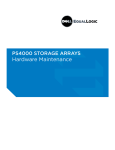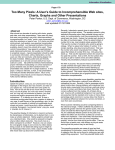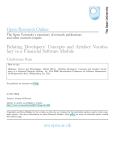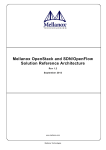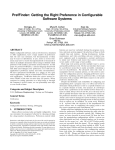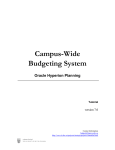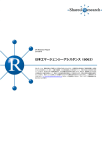Download Brocade Analyst and Tech Day 2012 – Dave Stevens
Transcript
1 Brocade Analyst and Tech Day 2012 – Dave Stevens Dave Stevens: Thank you, Mike, and good morning everybody. Thank you for taking the time to join us either here live in San Jose or via the webcast. Jason and I panicked a little bit there because when Mike said we were going to have kids help you configure fabrics out of the solutions center we initially thought he was talking about us. [laughter] But I think all the Mouse Squad folks can help you get through it and we’d encourage you to really go out there and try that and see some of the technology really in operation. Mike spent a little bit of time talking about this concept of simplicity in networking and it’s one of the major themes that we’re driving into our engineering teams and our product vision. So I want to take about 30 minutes this morning and just talk about simplicity, talk about what the means in the product sets and talk about why it’s so important to building the next generation of global communications infrastructure, which is what we’re all about doing here. I think it’s no secret that if you look externally the IT industry, in general, is in a period of very rapid transformation; maybe more dramatic than it’s ever been. We see very, very rapid change happening externally. And I think it’s happening so rapidly because we have multiple technology trends and societal trends are all compounding together to cause this changeover. If you think about out on the edges of the network, we’re putting a tremendous number of devices out on the edge of the network; tablets, smartphones, new Apple iPhones, video cameras, set top boxes. We’ve really put an unprecedented ability to source and consume information out on the periphery of the network. In data centers, 2 Brocade Analyst and Tech Day 2012 – Dave Stevens technologies like virtualization that continue to decline in the cost of storage and compute capacity; Flash arrays, the decline in the price of Flash memory; that’s allowing us to build very dense, very sophisticated, very information-rich data centers at an increasing pace. And connecting those two things is wide area bandwidth, where we see continued drop in the cost of wide area bandwidth and the continued increases in capacity. We’re going to talk a little bit about internet2 today and I think the changes, even from the original internet to internet2 have been, just incredibly dramatic. We’re adding so much capacity to that wide area network we’re effectively seeing the death of distance. It almost doesn’t matter anymore whether you distribute an application across the data center or whether you distribute it across the wide area; it’s gonna start working exactly the same way. In every organization that we deal with and we talk to is trying to figure out how to use this technology information and the technology infrastructure to benefit their businesses. They’re trying to figure out how to deploy distributed applications and everybody is building an IT stack consisting of both internal and external applications that are globally distributed. What’s very clear is that the network infrastructure that we built over the last 20 years, 25 years, wasn’t really built to host these applications. It’s insufficient in capacity. It’s overly complex. It’s difficult to manage. It’s too expensive. We have to upgrade that infrastructure over the next decade and that’s really what we’re building the product portfolio to do. I think there’s lots of external evidence that this is, in fact, the case. 3 Brocade Analyst and Tech Day 2012 – Dave Stevens Any of the industry reports you read on traffic growth talks about traffic growth, the cloud then across the wide area going up like what is the magnitude over the next 10 years? Venture capital investment in cloud technologies, and I would include software defined networking in as cloud technologies, you know, almost $7 billion last year; it was higher in FY12, I don’t have the exact figures, but these are companies and technologies that the venture investors don’t expect to turn into enterprise grade technologies and companies for three or five or ten years. So the expectation is that the change that we have seen over the last four or five years is going to continue to dramatically increase in pace. There was an interesting article out of Forbes that talked about the nature of application construction, Mike referenced it a little bit, but over 80 percent of applications today are built for cloud deployment. In a separate report out of Forrester, they talk about the average enterprise company now has 10 plus cloud-based applications and we’re a great example of this. I know last year when many of you were here you went over and you had the opportunity to go tour the data center over in building one. So that is an incredibly efficient data center. We drive it with a half a megawatt of photovoltaic arrays. More than 70 percent of the applications in that data center are virtualized. We have completely flat network architectures in there. We have state-of-the-art servers and storage systems from EMC and from HP and from IBM and others in that data center. Despite that efficiency as an organization we still host more than 30 percent of our applications 4 Brocade Analyst and Tech Day 2012 – Dave Stevens externally. Places like Salesforce and SuccessFactors; it’s just more efficient to do that and all of our customers are doing the same thing. They’re distributing applications out into the wider area; this is a great step. Nine billion objects at Amazon web services. YouTube streaming four billion videos a day. Akamai, which is doing a lot along with companies like Limelight to do content delivery and the acceleration of content on top of the existing network infrastructure today serving up two trillion requests a day and several hundred million hours of video on a daily basis. So, you know, the message here is that this transformation that we’re seeing across the network infrastructure is going to continue going forward. And there’s another actually interesting change that’s a little more societal in nature but it’s the focus of the CIOs. So over the last 20 years the majority of the focus within the IT organizations has been automating business applications. These are typically inside of the data center. They are things like HR applications, finance applications, database applications, manufacturing applications typically hosted inside the data center; this is the so-called systems of record that you hear guys like Geoffrey Moore and others talk about. There’s a change happening and that is that as we put more compute power out at the edge of the network individual users are effectively becoming their own IT department. So you give somebody an iPad and they have tremendous compute and storage and IO and connectivity capacity out on the network. They will now take information, both from your corporate site, from your competitors’ corporate site, from their colleagues, 5 Brocade Analyst and Tech Day 2012 – Dave Stevens from their partners, from your partners, from your customers and they’ll assemble that information, into their own solution. If you think about somebody like a realtor, they’ll take Google maps; they’ll look at information about a particular site. They’ll take MLS information out of their own site. They’ll take school information out of another local site. This so-called systems of engagement that are happening out there create tremendous problems for CIOs and it creates problems because one day there’s traffic, the next day there’s no traffic. The traffic patterns become completely unpredictable. If you think about this room, yesterday there’s no traffic coming out of this room. Today, all of you are logged onto corporate sites. You’re all taking notes. You’re logged onto websites. You’re doing research. Some of you may be on ESPN.com downloading football stats so you can score your fantasy football league. But the idea is there was no traffic here yesterday. Today you’re all connecting. You’re generating a couple of gigabits of traffic. From a networking perspective, that is incredibly difficult to predict and incredibly difficult to build a network around, yet that’s what we’re asking CIOs to do inside of their buildings; it’s what we’re asking carriers to do in the service provider network; it’s what we’re asking them to do globally. And to get that done the model that we have to actually pursue is we have to go to the engineering and the product guys and say “I want you to build me, effectively, a limitless global network. I want you to build me the next generation of the internet. I want connectivity everywhere. I want it to be lower cost. I want it 6 Brocade Analyst and Tech Day 2012 – Dave Stevens to be more pervasive. I want everybody to be connected to it.” And one of the things that’s become clear as we all struggle to build this next generation network is that simplicity and architecting out complexity is going to be one of the keys to actually getting this done. And that’s why the focus on simplicity within the engineering teams and across the product groups. We’re telling them “You don’t get to take out features, you have to make it simpler to use and you have to make it more reliable and you have to make it more automatic.” The question is how do you do it? So the key here is not taking out features. It’s not de-featuring products. It’s not just throwing speed at the problem. It’s not throwing bigger pipes at the problem. It’s also not about mastering the complexity. Mike touched on this a little bit. We can’t get simplicity into networks by more training of technicians, smarter technicians, more highly trained, highly skilled work forces that just master the complexity that’s inherent in all of these systems. We actually have to create an abstraction layer so that they’re easier to deal with. And guys like Scott Shanker and Martin Casado of Nicira, now VMware, have spent a lot of time; they’ve got some excellent discussions on this but the idea is to basically create an abstraction layer that makes things easier to use. Historically this has been the way that we architect simplicity into technology. On top of command lines and DOS we put Windows systems. On top of assembler language we put languages like Ruby and Java and Visual Basic and other types of high level programming language. Instead of trying to figure out how to record TV shows 7 Brocade Analyst and Tech Day 2012 – Dave Stevens by correctly setting the clock on our VCR, instead we just go buy a TiVo. We pick a show off the menu. We hit season pass and the next thing we know we’ve got every episode of West Wing for the last two years on the hard drive and we can watch them whenever we want and probably the ultimate abstraction is tablet computers today. I would venture to say that nobody in this room has opened or read a user manual for an iPad. So that’s not a statement, by the way, about your collective ability to follow instructions or read or anything like that. It’s that nobody needs to open it. It’s just intuitive is the way it operates. You pick it up. You know how to use it for productive applications. You’ve probably never seen the operating system that’s embedded in that device; that is a tremendously complex device and yet they’ve managed to add an incredibly elegant user interface on the outside of it that makes it useable without seeing that complexity; that’s the level of abstraction that we want to get to through simplicity in all the network infrastructure and technologies that we bring to market. So there’s two main areas where we’re doing a lot of work that I’ll highlight today and then we’re going to have Jason talk more about these areas of fabrics and Ken talk more about software defined networks and carrier networks. Fabrics are an architectural change that are happening in data centers and they are an abstraction that is the key to building next generation infrastructure for cloud and enterprise data centers. They allow you to take these tremendously complex networks that we’ve built over the last 20 years and create a picture for users that are a flat, 8 Brocade Analyst and Tech Day 2012 – Dave Stevens layer 2 surface area that’s ideal for multi-tenancy; that’s ideal for virtualization; that’s easy to manage and less expensive to implement. And we’ll talk more about fabrics in a minute. Software defined networking is a relatively new emerging set of technologies. It’s a bunch of different companies, a bunch of different technologies but the idea is to basically add a software abstraction layer for provisioning and management and control on top of the physical infrastructure and give users the ability to basically enable programmatic software-based control over the physical infrastructure; that’s the whole idea behind SDN. So, let me talk a little bit more about fabrics. What’s driving the architectural change from fabrics? Because you’ve heard us talk about this and we’ve been talking about it for three years now. We’ve been shipping the products for about two years against this vision. What’s driving the change to fabrics because it is happening industry-wide? The answer is a change in application architecture. So, traditionally, we built very large monolithic applications. We took the applications. We put it on a compute node. We connected it up to an Ethernet network and a fibre channel network. We tuned the network and configured the network and then we let it sit there and we used it until the end of the useful life of the application and nobody really modified it. You go into a company today and look at a 20-year old payroll system and they’ll tell you that they’re scared to death to touch it because of the complexity of that application; it doesn’t move. Modern application development doesn’t work like that. Modern application development is 9 Brocade Analyst and Tech Day 2012 – Dave Stevens modular. It’s built out of a series of virtual machines. The virtual machines run on different servers and that creates east/west traffic patterns within the data center. And if you have an application that you’ve built out of 8 or 10 virtual machines and you’re not happy with the way the middleware layer is running, you simply pick up the middleware layer and move it to a faster server. Well, that just changed all the traffic patterns of your data center. You broke all your firewall security rules. You crossed all your VLAN boundaries. You blew up all your VRF instances. It doesn’t work. And so the reason there’s a migration to fabric-based architectures is the traditional deep classic complex architectures that we’ve built over the last 20 years and everybody’s guilty of this and that’s what exists today; that doesn’t work for east/west traffic and it doesn’t work for virtualization and it doesn’t work for cloud data centers. With a bunch of really smart technicians you can try and get by but there is an industry-wide move to flat, fast architectural networks, what we’ve termed fabrics and we’re doing this. Every other company in the industry is doing this. We’re leading the charge to go do this. We’ve been talking about it for more than two years but this is the theory behind fabrics; create a flat, fast abstraction layer on top of the network infrastructure to make it easier to run; make it more efficient; make it better for virtualization. I’ve used this slide, I think, in both of the last technology days starting in 2010 and I’ll really just use it to remind you that not only are we talking about fabric technologies and have been talking about fabric technologies, having started development in this 10 Brocade Analyst and Tech Day 2012 – Dave Stevens area back in 2008, but we are delivering products and technologies and production customers against this vision. Back in, early January of 2010, we were one of the first companies to come out and support the industry recognized, industry standard mechanism for building flat Ethernet fabrics, TRILL. And there were other vendors that came out and support it as well. Cisco is an example of a company that it also has done a tremendous amount of work in this area. We have to give them credit as well. But they’ve come out and supported this as well. We came out five months later at technology day in 2010 for those of you that were here and we talked about a product set that we were going to ship against that vision. We talked about TRILL-based ASICs. We talked about a new operating system. We talked about virtual machine integration, about mobility and port profiles, if any of you remember this discussion, and we used this exact same slide. And then we delivered it in December of that year. We delivered another set of products in September later in that year. We delivered Multi-hop FCoE. We delivered native fibre channel interfaces. We delivered scale and stability in production class products against that vision. Today one of the things you’re going to hear Jason about is more progress in the fabric area, where we’re going and what we’re doing next. But the thing that you can count on is when we say we’re going to deliver something we deliver the products, we deliver the customers against that vision; it’s something we’re tremendously proud of. We’ve also started shipping embedded blade server switches based on our VDX technology to major 11 Brocade Analyst and Tech Day 2012 – Dave Stevens manufacturers around the world. We shipped one embedded blade server switch in May. We shipped another one this month. We’ll do more of those over the next year or two. So there’s a general industry resonance around the VCS technology and around the fabric technology in general. Now fabric is a great technology for simplifying the physical infrastructure inside of a data center but customers want to do more than that. They want software programmability of that infrastructure. They want full virtualization of the physical infrastructure so that they can be faster about provisioning so that they can configure multi-tenancy, so that they can configure an application at much higher speeds, so that they can get network visibility. The SDN industry was really built to go deliver on this vision of getting to software programmability of the network infrastructure. The reason it’s necessary is you can’t do it very well with the existing infrastructure; there’s some major challenges in there. All the intelligence within the existing network infrastructure and within existing architectures, reside in the devices themselves not in an external application. Because it resides in the applications itself, a lot of times it’s proprietary; a lot of times it’s vendorspecific. There is no mechanism to get network-wide visibility as to what’s happening. You can’t make global decisions against that infrastructure. This idea of adding programmability in an industry standard way to these network infrastructures is what SDN is all about and it’s what all those companies are all about. So we have a very detailed blueprint and architecture that I will save 12 Brocade Analyst and Tech Day 2012 – Dave Stevens you from and not take you through completely. Ken Cheng will spend a little bit more time talking about the specific deliverables that we’re bringing to market against this roadmap but effectively it looks like this. You put fabrics at the bottom, at the network layer, that allow you to build a very simple, flat, automatically provisioning network as the base of getting this done and then on top of it you begin to layer simplicity SDN technologies and different capabilities. Tunneling technologies like VXLAN, STT, which is what Nicira was using, NVGRE, which is what Microsoft is proposing as a tunneling mechanism. Things like Open vSwitch and OpenFlow; all those technologies can be used to begin to virtualize that physical infrastructure. On top of that, once you have global visibility, are some very interesting applications that you can layer on top of that physical infrastructure. As an example, utilization in many of the wide area networks that we see is not very high. You know, you’ll have one link that’s running at 95 percent utilization; it’ll be running right next to a link that’s running at 20 percent utilization. If you can step back and take an application and have global visibility to utilization across all those links and what all the virtual machines are doing and what all the traffic is doing, you can program the network to redistribute application information and traffic flows across those wide area links and you can balance technology across those links and get the utilization of the links to rise dramatically up to 80 or 90 percent; that saves a tremendous amount of money. That’s just an example of an application that sits above the network that uses global visibility of the 13 Brocade Analyst and Tech Day 2012 – Dave Stevens network infrastructure to make smart decisions and to make the network operate more efficiently. Then, of course, there are a number of different technologies that are out there for doing orchestration and control of the physical infrastructure. A great resource if you haven’t taken a look at this is go to a site like SDN Central where Matt Palmer does a bunch of very interesting work and look at the list of open source projects under SDN there and you’ll see hundreds of open source projects around orchestration, around virtual switching, around different layers of programmability within the networks there’s a tremendous amount of activity. It’s not clear who’s going to win in that, what technologies are going to survive, what’s not going to survive; it’s early in that industry but it’s tremendously exciting and it allows us to bring industry-wide programmability onto the network infrastructure. So the way that I would encourage you to think about these two technologies as we talk about them throughout the day because they really work in concert, we’re trying to get from this idea of physical complex infrastructure to something that’s simpler and easier to run and is automatically provisioned and selfmanaging; that’s the migration from traditional data center infrastructure to fabrics. Then on top of that we’re trying to move from manual configuration and manual controlled command line interfaces, box by box configuration within the data centers. We’re trying to take this tremendous set of tools that’s coming available within the industry; things like VXLAN from VMware, NVGRE, cloud IDs which were a modification to the TRILL headers which we’ve talked 14 Brocade Analyst and Tech Day 2012 – Dave Stevens about a couple times for creating multi-tenancy environments within flat layer 2 networks; OpenStack, which is a fantastic open provisioning and management tool that’s being driven by the open networking foundation where we’re participating very actively; the Open vSwitch, the Quantum Interface; there’s hundreds of these applications. Collectively, this SDN technology, again, allows us to add a programmatic interface on top of the physical infrastructure. And when you couple that with what we’re doing on the physical infrastructure this is how you get to a software vision, a software driven, fully virtualized data center and how we take that technology and expand it across the wide area network. This is how we add abstraction layers on top of the technology that’s being deployed out in the network. So just a couple of closing thoughts. So I’m a little bit of a technology guy by background. As I know most of you know I’m a little bit of a technology geek. I love this stuff. And it is a tremendously exciting time in this industry. It is exciting to go over to building 2 and building 1; watch what the engineering teams have developed; help direct that engineering and to see the products come out of that and to see the broad industry change that’s happening. I think we’re fairly early in the transition to sort of the next generation of global communications infrastructure and I think the transition is actually accelerating, which is exciting if you’re in the product space. This idea of simplification, of putting abstraction layers and taking complexity out of the networks is absolutely required throughout the next generation infrastructure. 15 Brocade Analyst and Tech Day 2012 – Dave Stevens We have to build simpler to use, easier to operate, more automatic product sets or we really cannot achieve the scale necessary to make this network worldwide and make it this idea of this limitless broadband network. The key to doing that, as I said, is not taking features out. It’s not dumbing down products. It’s not just throwing speed at the problem. It’s not training people so that they can master the complexity. The idea is to create smart abstraction layers, which is incredibly difficult to do. If you think about the iPad; it is incredibly difficult to make that thing easy to use but yet there it is. There’s tremendous complexity inside of the device but you don’t see that on the outside. It’s that kind of abstraction and that kind of simplification that we have to bring to network and infrastructure technology. We’re going to do that by using fabrics to simplify the physical infrastructure first in the data center but then over time, we’ll extend that technology to the wide area; we’ll extend the technology within campus networks; we’ll use it in service provider networks because it’s an incredibly powerful abstraction and it works, as you’ll see out in the solution showcase today. Then we’re going to tie software defined networking technologies, a number of different technologies, on top of that fabric infrastructure to give us this programmatic control and to create an abstraction layer from a management and provisioning standpoint on top of the physical infrastructure; those two things are key to driving the technology vision forward and they’re really the foundation for building this next generation global communications infrastructure. So that’s at a high level 16 Brocade Analyst and Tech Day 2012 – Dave Stevens where we’re headed. Thank you for your time.


















